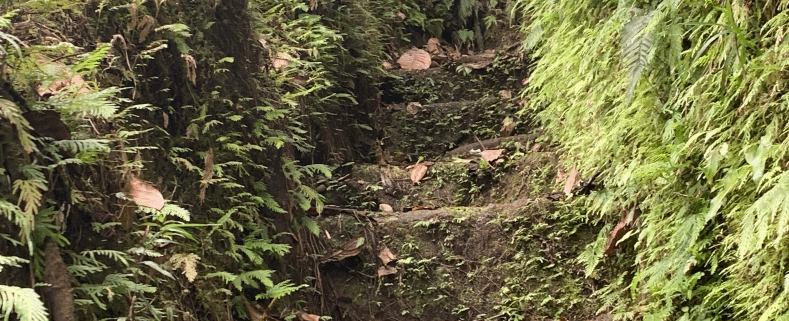
Please note: Contrary to the usual schedule, this talk is on a Wednesday!
RSVP for attending the talk remotely (Zoom): https://ucla.in/3WvjYFm
Speaker:
Jonathan Rodriguez
McKnight Doctoral Fellow
Dept. of Anthropology, University of South Florida
Paper:
Justin Dunnavant (Discussant)
Assistant Professor, Dept. of Anthropology, UCLA

Jacko Steps, Jacko Flats Trail, Dominica. The stone steps were built by Chief Jacko, an 18th-century leader of escaped slaves, to access their Maroon settlement and protect it against colonial forces. Photo by Jonathan Rodriguez.
In British colonial Dominica from 1763 to 1834, Maroons resisted enslavement by establishing fugitive geographies of resistance in the mountainous hinterlands of the island. The physical landscape of the island afforded Maroons a space to create communities, survive in the rainforests, and resist European colonialism and enslavement. This geospatial analysis of refuge settlements illustrates how Maroon geographies and Black ecologies within the untamed interior of Dominica disrupted cartographical concepts of European settler colonialism based on order, hierarchy, and exploitation. Most importantly, this legacy of fugitive spatial methods and ecological practices was later employed by Rastafarians during the oppressive era of the Dread Act. After discussing the regional study, I shift to the site-based survey highlighting the results of the community-based archaeological and digital heritage project at Jacko Flats. Jacko Flats is located near the rural village of Belles in the Central Forest Reserve, and its place name signifies the location of a Maroon settlement occupied by self-emancipated formerly enslaved Africans under the leadership of Chief Jacko from 1764 to 1814. The archaeological project at Jacko Flats embraced this idea of creating community by collaborating with the Create Caribbean Research Institute at Dominica State College, self-identified Dominican Maroon descendants, local scholars and interested site visitors, and Rastafarians. The results of the community-based archaeological project demonstrate how prioritizing collaboration facilitated the inclusion of interpretations of the site that are often neglected. I also reflect on the challenges and solutions for developing a community-focused archaeology project in the isolated hinterlands of Dominica.
Biography: Jonathan Rodriguez is a McKnight Doctoral Fellow in the department of Anthropology at the University of South Florida. In 2023, he received a Fulbright U.S. Student Research grant to teach digital heritage methodologies to interns at Create Caribbean Research Institute and to conduct the first archaeological investigation of a Maroon settlement on the Caribbean island of Dominica. His research interests include historical archaeology, Caribbean archaeology, Geographic Information Science and digital heritage research, and Maroon studies.


